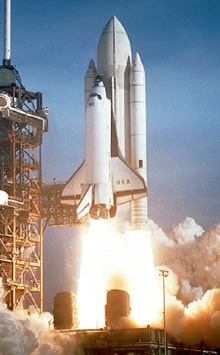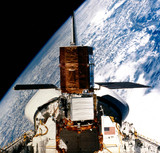History
The program was launched at the end of the program Apollo at the beginning of 1970s (January 5, 1972 by President Nixon) a time when budgetary restrictions for the NASA already began, what led them to look for the most economic means to maintain a human presence in the space.

Purpose of the Space Transportation System
Every shuttle was conceived to make hundred of flights. One of the main objectives of the program was to build and to deserve an orbitale space station, what is coming true with the assembly of the international Space station (ISS), and to send satellite in orbit.
The shuttle was also conceived to repair satellites in orbit, and to bring back orbital payloads. It was the case of Solar Max satellite in 1985 and repeatedly the spatial telescope Hubble.

Thinking ahead to what NASA would in terms of human spaceflight the Apollo Moon landings, in the President's Space Task Group, by Vice-President Agnew, offered several The Space Task Group report three main options: a human to Mars, lunar and Earth-orbiting stations, and a reusable space or Shuttle. President Richard Nixon the first two options as expensive. NASA then decided to for a Shuttle as a block for these other goals, the space station. NASA officials that the Shuttle would be popular with Congress and the House than the other, more options. Nevertheless, in 1971 the of Management and Budget (OMB) NASA's budget, eliminating any growth the foreseeable future.
During the development program that soon some managers simply discounted or predictions of such high flight as unrealistic. Indeed, some managers that such lofty proclamations were for public consumption or public purposes and thus did not them seriously. In retrospect, Robert the Shuttle project manager at Johnson Space Center (JSC) said I never felt we d more than once a month, 18 flights a year [at maximum]. Even if virtually all payloads were to fly aboard Shuttle, Thompson couldn t figure the country would want to with all those flights that predicted by Mathematica.22 Another key remarked that there was a requirement for 55 flights per mainly to support the economics the system. In effect, the was wagging the dog; instead creating a launch system versatile rugged enough to launch often thus reduce operations costs, some were artificially creating a launch to justify a particular kind technology.

